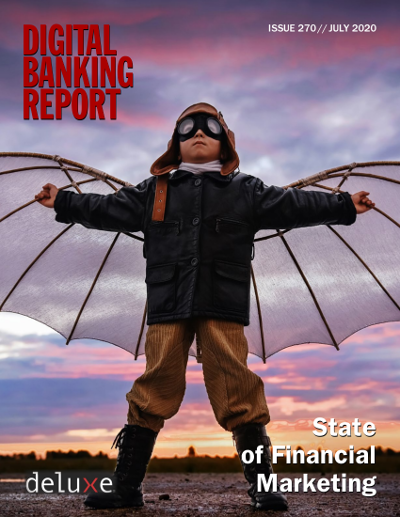State of Financial Marketing
Jim Marous
July 2020
: DBR 270
112 pages, 51 tables/charts
Download Printable Version of this page
In a matter of weeks, the economic and emotional effects of a worldwide pandemic slowed business and immediately altered the ways we engage with consumers. Financial marketers went into crisis mode, helping customers adjust to new digital engagement realities and finding ways to help customers navigate potential financial hardships.
Financial marketers were immediately thrust into the spotlight, as products and solutions were being rebuilt for a much more digital future. Instead of selling products, marketers focused on educating consumers on digital options, retaining relationships and strengthening brands, while realizing they were unprepared to deliver the level of personalized messages to consumers that they expected.
While marketing budgets rose with the onset of the pandemic, most financial marketers believe budgets will be reduced in the near future. Doing more with less will be a challenge given how much needs to be done. Of central focus is the need to improve the use of data and analytics for improved customer communication, offer development, marketing channel selection and measurement of results.
The impact of COVID-19 on consumer behavior and financial marketing becomes evident immediately upon review of the results of the 8th annual State of Financial Marketing report, sponsored by Deluxe. In fact, across the board, changes in almost every area of the research were more dramatic than in any previous report. This is because consumer shift to digital advanced years in a matter of weeks.
It is clear that many of the shifts in consumer behavior, marketing spend, solution prioritization, use of data and technology, and even marketing talent deployment will unlikely revert to pre-pandemic norms. Some of these changes represent accelerations of previous trends, while some are new trends altogether. It is yet to be seen the duration of these changes, but each deserves a careful review.
As far as megatrends are concerned, the following should be considered in the future deployment of financial marketing resources:
-
- Shift to digital. While not every consumer will want to do all of their banking digitally, most will expect that option in the future. This ranges from opening a new account, to changing the terms of a loan, to reaching a bank representative. The experience must go beyond ‘just digital’ to be both seamless and simple.
- Contextual engagement. The expectation of real-time personalized offers and messages has increased dramatically. This requires a 360-degree view of the customer journey and advanced analytics to deliver solutions across channels … instantly.
- Platformification. As has been done in other industries, financial institutions need to look beyond the standard set of services and consider platform solutions that assist consumers during select customer journeys (car buying, investing, home purchase, etc.).
- New channel mix. With the potential for many consumers to work remotely indefinitely, a new set of delivery channels may include voice devices, new videoconferencing options, IOT devices, TV screens and entertainment platforms (video games, podcasts, etc.).
- Focus on brand value. Social consciousness, sustainability, and brand accountability have experienced a surge in importance as a result of COVID-19 and recent social events. Organizations will need to put words into action.
- Enhanced privacy and security. With increased sharing of data and use of digital channels, cybersecurity becomes paramount. Transparency about how data and privacy is being protected will fall into marketing’s lap.
Financial marketing is entering a new digital era, ready or not. This will impact the channels selected, the technologies used and the importance of having the appropriate talent to meet the needs of the future.
This is occurring with the reality that everything we know today could change in a ‘pandemic moment’ if another major shift in fortunes occurs.
State of Financial Marketing
Advanced Analytics, AI, Analytics, Artificial Intelligence, Bank, Banking, Big Data, Credit Union, CRM, Customer Experience, Digital Banking, Digital Lending, Digital Marketing, Digital Transformation, Engagement, Fintech, Innovation, Marketing, Mobile Banking, Payments, Personalization, Technology, Trends, Voice Banking, Voice-First

